|
|
Post by Cei-U! on Dec 15, 2018 20:05:32 GMT -5
The "Invisible Man" adaptation in Supernatural Thrillers #1 was in my Top Twenty but didn't make the final cut.
Cei-U!
I summon the near-miss!
|
|
|
|
Post by Reptisaurus! on Dec 15, 2018 20:48:32 GMT -5
#10- GUMBY'S WINTER FUN SPECIAL & GUMBY'S SUMMER FUN SPECIAL Written by: Bob Burden & Steve Purcell Drawn by: Arthur Adams (1987-1988) Oh yeah, good one. |
|
|
|
Post by wildfire2099 on Dec 15, 2018 22:13:25 GMT -5
10. Carson Napier Adaptations DC Comics 1974-75 (back up stories in Korak, Son of Tarzan) by Len Wein/Mike Kaluta While this isn't really my favorite ERB story, the comic adaption is fantastic... Kaluta really knocks it out the park with the art. It was a great surprise when I bought these.. I was getting them for Korak, then after reading them the backup was far better than the main story. 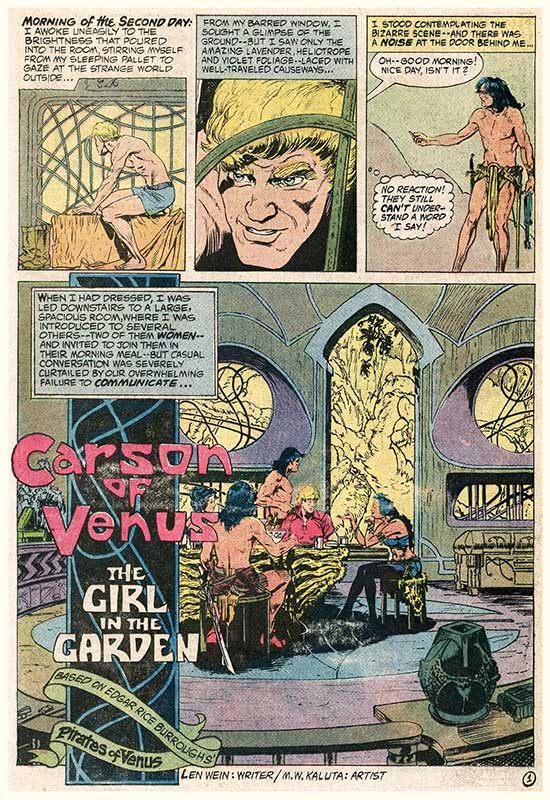
|
|
|
|
Post by foxley on Dec 15, 2018 22:19:54 GMT -5
10. Doc Savage: Man of Bronze #1 - 4 (Millennium, 1991) When this year's topic was announced, I found myself wondering if a Doc Savage tale would make my list. I am a huge fan of the Man of the Bronze, but he has never been particularly well-served by his comic book incarnations. Which is odd given that he was a huge influence on the development of both Superman and Batman. But, for some reason, his comic appearances have generally been lackking: from the underwhelming (Marvel's colour series) to the adequate (Marvels b&w magazine) to the misguided (DC's 1980s book) to the regrettable (DC's First Line book). And I found myself wondering why this is. The conclusion that I came to is that the comic books insist on putting Doc front and centre of the action. This is understandable. He is the central character after all, and the most visually interesting. But, in the novels, Doc tends be 'off-screen' for much of the action, with events seen through the eyes of Doc's aides, who are just as much in the dark as to Doc's plan as the reader. This strips Doc of much of his mystique. And the adaptations insist on shoe-horning all five of Doc's aides (and often Pat) into every story. Very few of the novels actually featured the entire cast, and this results in the comics feeling crowded, and not much room for character development among the Fabulous Five. So, after this 'insight', I found myself wondering if any of the adaptations did warrant a place on my list. To my surprise, I can up with two possibilities. After weighing things up, several intangibles, I decided on the Millennium series; partly because I feel it is the more obscure. In particular their first miniseries Doc Savage: Man of Bronze (which, despite sharing a title with the first Doc Savage novel, is not a retelling of it). This is a solid little tale. The writer understood the beats of a Doc Savage novel, and managed to hit them perfectly. And included some jokes for the fans, such as talking about getting the jetpack from a kid in California (a Rocketeer reference). And he did not feel the need to rewrite Doc to update him, or make him 'relevant'. What we ended up with is a solid Doc tale that would not be out of place in the novels (and would be better than some of them). The later minis are decent, but always felt a bit rushed, and the artwork deteriorated as the run went on, before finally sinking along with the rest of Millennium. But it is good to know that there is at least one example of Doc savage done right in comics.
|
|
Confessor
CCF Mod Squad
Not Bucky O'Hare!
Posts: 10,197 
|
Post by Confessor on Dec 15, 2018 22:26:54 GMT -5
Strange Tales #130 (Marvel, 1964) Script: Stan Lee Artwork: Bob Powell/Chic Stone  So, it's specifically the Beatles' fictional appearance in the Human Torch and Thing story in this particular issue of Strange Tales that I'm choosing for today's choice. Published in 1964, the tale is titled, appropriately enough, "Meet the Beatles" (which was also the title of the Fab Four's debut album for Capitol Records in the U.S.). The story sees Johnny Storm and Ben Grimm taking their girlfriends, Doris Evans and Alicia Masters, to see a Beatles' concert in Manhattan. Unfortunately, Johnny and Ben don't actually get to see the concert because they have to chase down some crooks who've robbed the theatre box office, but they do get to briefly interact with the band. The girls, on the other hand, not only get to watch the concert, but they also properly meet the Beatles and get their autographs! In all honesty, this really isn't a great story or anything. I mean, really...it's nothing to write home about at all. Plus, the depictions of John, Paul, George and Ringo leave a lot to be desired. But who cares! It's the Beatles...in the Marvel Universe...interacting with the Human Torch and The Thing. I mean, seriously, THE BEATLES! And half of the Fantastic Four! 'Nuff said! 
|
|
|
|
Post by Deleted on Dec 15, 2018 22:51:25 GMT -5
On the Third Day of Christmas, Santa sung unto me a song of wonder and woe about a different sort of elf… Thomas the Rhymer adapted by Sharyn McCrumb and Charles Vess from the Book of Ballads and Sagas #1; Green Man Press, 1995;  adapted from Child's Ballad #37 Thomas the Rhymer 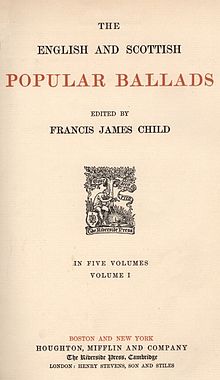 and based on a historical figure... (spoiler to keep visible images down to 2 per Kurt's request) A traditional Scottish ballad about True Thomas, i.e. Sir Thomas de Ercildoun, a 13th century Scottish laird and reputed prophet, telling how he was taken to Faerie by the Queen of Elfland and returned with the gift of prophecy and the inability to tell a lie. The whole series of Ballads and Sagas is Charles Vess at his best, but this is one of my favorite medieval folk tales and Thomas the Rhymer is a figure who appears often in modern urban fantasy and other tales concerning Faerie. Vess work here is gorgeous and McCrumb’s adaptation of the ballad is superb. Clocking in at only 10 pages, this work is short but oh so magnificent. This is my favorite version of this tale, but Ellen Kushner's novel, Thomas the Rhymer is also a favorite, though it tells a much more detailed and expansive version of the story. Thomas the Rhymer was also (indirectly) an influence on one of my favorite (and longest played) D&D characters, and a favorite figure from history and folklore for me for a long time. The plate of this cover from Vess' Ballads and Sagas portfolio is framed and on my wall as well. I had the entire 4 issue series on my initial list, but several of the ballads are based on mythology/folklore without an attributable author, so weren't eligible, but this one if a fictional tale of an actual historical figure, so I hope passes muster. -M |
|
|
|
Post by Deleted on Dec 15, 2018 23:01:41 GMT -5
10. Supernatural Thrillers 3, April, 1973"The Valley of the Worm"
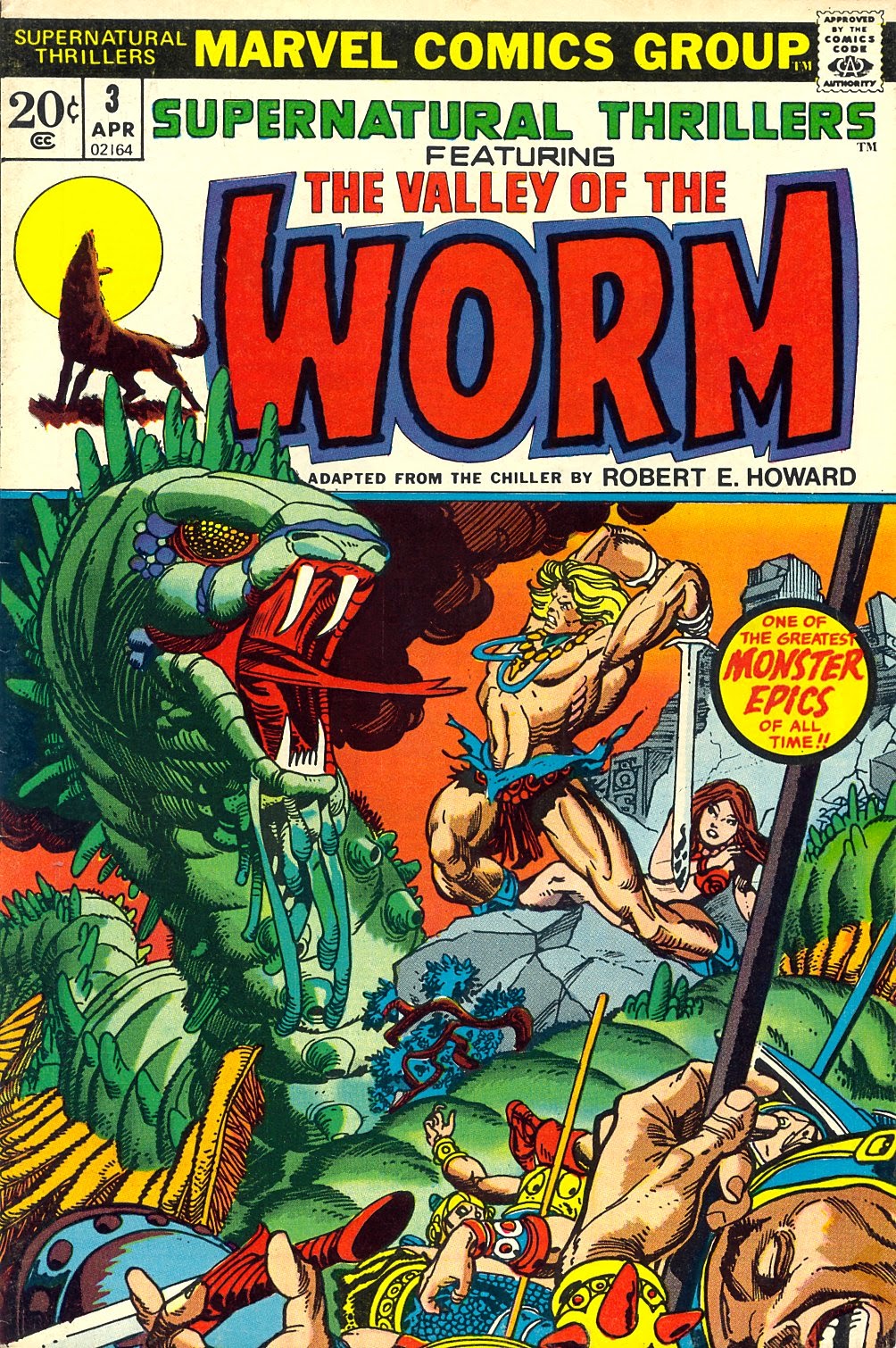 My guess is that this won’t be the only mention of this particular Robert E. Howard story, and certainly won’t be the only mention of Howard. It popped up in Supernatural Thrillers, another of those anthologies that got off to a good start but couldn’t sustain the quality of its first few entries. And this entry was one of its best, a rousing pedal-to-the-metal REH epic, which meant most of his tried and true tropes in ample supply: legendary warrior paired with a dark-skinned noble savage; duels with all kinds of beasts; the notion that “primitive” man was not as primitive as the civilized kind might have thought; the superiority of Cro-Magnons (Aryans) to Neanderthals (All other races); the warrior’s code derived straight form the Vikings; shattered bone, split skulls and the heady brew of berserker-style battles; and women as arm-candy. And yet… There is a thin patina of sophistication in that the protagonist, one James Allison, is near death at the story’s start and is fever-dreaming about his exploits in a previous life as Niord, the hero of his people who must go one-on-one with the foul Worm’s-Bane of the title if his race is to survive. Howard is channeling Jung and his theory of archetypes, and foreshadowing Joseph Campbell's Hero with a Thousand Faces, as this magnificent two-page spread informs us: 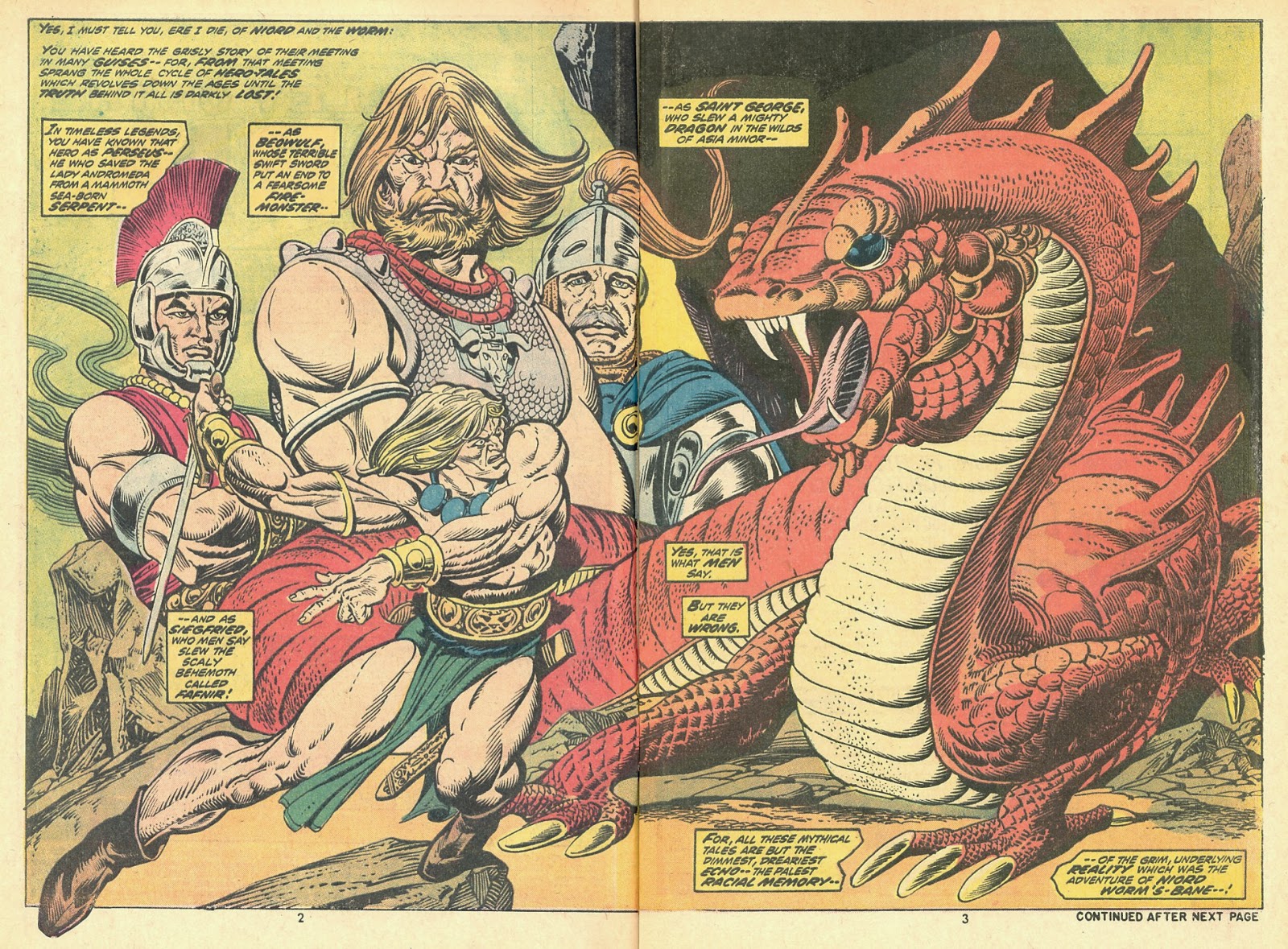 Nothing subtle here, just a rip-snorting adventure from the dawn of history in which Niord, aka Allison, enacts the archetypical struggle between the great hero and the dragon. The real treat here is the absolutely drop-dead art by Gil Kane, who was not just yet drawing in the minimalist style that marked so much of his late work. The backgrounds are jam-packed with detail, the characters are uniquely designed and costumed, and the layouts are stunning. Much of the reason the art sings, though – and I frikkin' can’t believe I’m going to say this, Slam_Bradley – is Ernie Chua's excellent inking. Damned if he doesn’t seem to have become Ralph Reese for a day, and embellished Kane so deftly that he doesn’t obscure the details and still gives Kane’s lines a rough, primitive look. I can remember reading this and being knocked out, even though I was beginning to worry that sword and sorcery was getting so popular that there was too much of it starting to appear and that the quality and uniqueness of the different titles was going to be impossible to maintain. That would eventually happen, but not on this one. As good an adaptation of Howard as you were-- or are -- going to see in a tidy 21-pager that presented him as the atavistic, unsentimental, fatalistic man born after his time that he was. When I did my first brainstorm for the list, I was sure this would make the top 12, but it got moved down a bit as I remembered other things I wanted to include, so I am glad to see this one on the countdown. -M |
|
|
|
Post by Deleted on Dec 15, 2018 23:03:56 GMT -5
#10- GUMBY'S WINTER FUN SPECIAL & GUMBY'S SUMMER FUN SPECIAL Written by: Bob Burden & Steve Purcell Drawn by: Arthur Adams (1987-1988)  "He was once a little green slab of clay.... GUMBY!" Art Clokey's timeless animation was suitable to comics. I loved watching reruns of Gumby when I was little. When Comico made these in the mid-80s, this was a must pick up. I'm putting these together because you can't have one without the other. Bob Burden's comedy writing was a great start of the two specials. A right mix of all ages fun and little adult flair, like most of his comics are. Art Adams... would you ever expect him to draw Gumby and crush it like a champ? I'm a sucker for all things Art Adams and its so nice to see him do interiors, even back then! Winter Fun writer Steve Purcell, of Sam and Max fame, brought his own weird zany fun to Clokey's world. Gumby, Pokey, the Blockheads, underground monsters, astronaut bears.. these books are worth picking up  D'oh, I totally forgot about these; they would have gotten some consideration if I had remembered them. I read about them in an Amazing Heroes Preview Special and hunted them down when they came out on the stands. -M |
|
|
|
Post by Deleted on Dec 15, 2018 23:08:14 GMT -5
10. Doc Savage: Man of Bronze #1 - 4 (Millennium, 1991) When this year's topic was announced, I found myself wondering if a Doc Savage tale would make my list. I am a huge fan of the Man of the Bronze, but he has never been particularly well-served by his comic book incarnations. Which is odd given that he was a huge influence on the development of both Superman and Batman. But, for some reason, his comic appearances have generally been lackking: from the underwhelming (Marvel's colour series) to the adequate (Marvels b&w magazine) to the misguided (DC's 1980s book) to the regrettable (DC's First Line book). And I found myself wondering why this is. The conclusion that I came to is that the comic books insist on putting Doc front and centre of the action. This is understandable. He is the central character after all, and the most visually interesting. But, in the novels, Doc tends be 'off-screen' for much of the action, with events seen through the eyes of Doc's aides, who are just as much in the dark as to Doc's plan as the reader. This strips Doc of much of his mystique. And the adaptations insist on shoe-horning all five of Doc's aides (and often Pat) into every story. Very few of the novels actually featured the entire cast, and this results in the comics feeling crowded, and not much room for character development among the Fabulous Five. So, after this 'insight', I found myself wondering if any of the adaptations did warrant a place on my list. To my surprise, I can up with two possibilities. After weighing things up, several intangibles, I decided on the Millennium series; partly because I feel it is the more obscure. In particular their first miniseries Doc Savage: Man of Bronze (which, despite sharing a title with the first Doc Savage novel, is not a retelling of it). This is a solid little tale. The writer understood the beats of a Doc Savage novel, and managed to hit them perfectly. And included some jokes for the fans, such as talking about getting the jetpack from a kid in California (a Rocketeer reference). And he did not feel the need to rewrite Doc to update him, or make him 'relevant'. What we ended up with is a solid Doc tale that would not be out of place in the novels (and would be better than some of them). The later minis are decent, but always felt a bit rushed, and the artwork deteriorated as the run went on, before finally sinking along with the rest of Millennium. But it is good to know that there is at least one example of Doc savage done right in comics. The interior art on these was some of the earliest pro work of Daryl Banks (better known as the artist behind most of the Kyle Rayner run of GL), who is local here and a regular on our con circuit. He was pleasantly surprised when I brought the first issue for him to sign at Gem City a couple years back as it was one of the few times he has had anyone bring it to him. He talked about how much he learnd doing the series and how hard it was to live up the bar set by the Stelfreeze covers on the books. -M |
|
|
|
Post by codystarbuck on Dec 15, 2018 23:17:17 GMT -5
My number 10 is Bernie Wrightson's adaptation of Frankenstein.  Most people, when they adapt Frankenstein, look at the James Whale film, not the original novel. not Wrightson; he went to the source. He sets the story fully in the period where Shelley placed it, he makes it look like it was produced then. 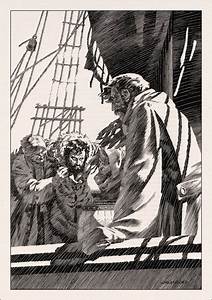 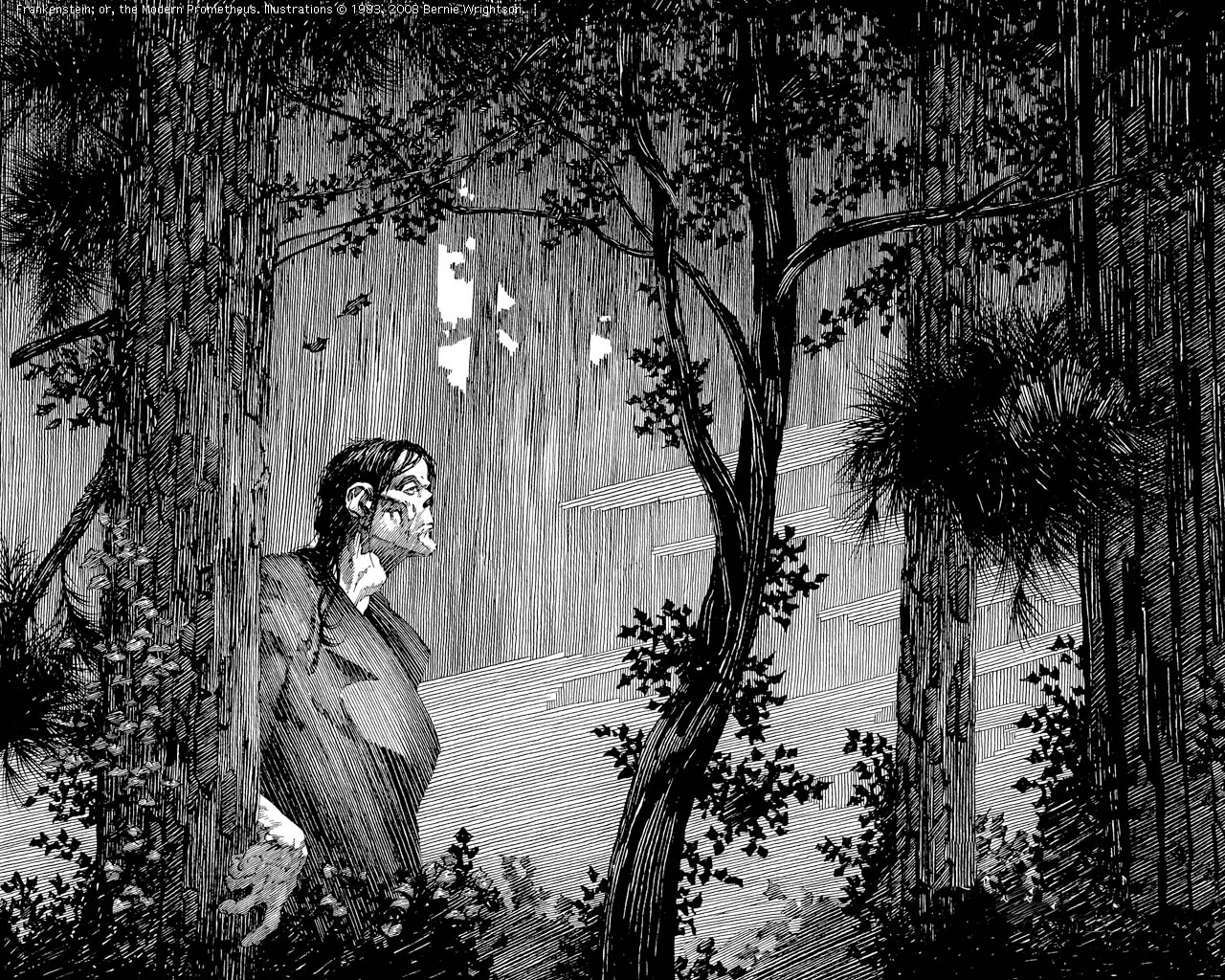 Wrightson makes the illustrations look like woodcutts, of the period, which gives a creepy edge to everything. It is stark black and white, with tons of small details. It is just amazing to look at. 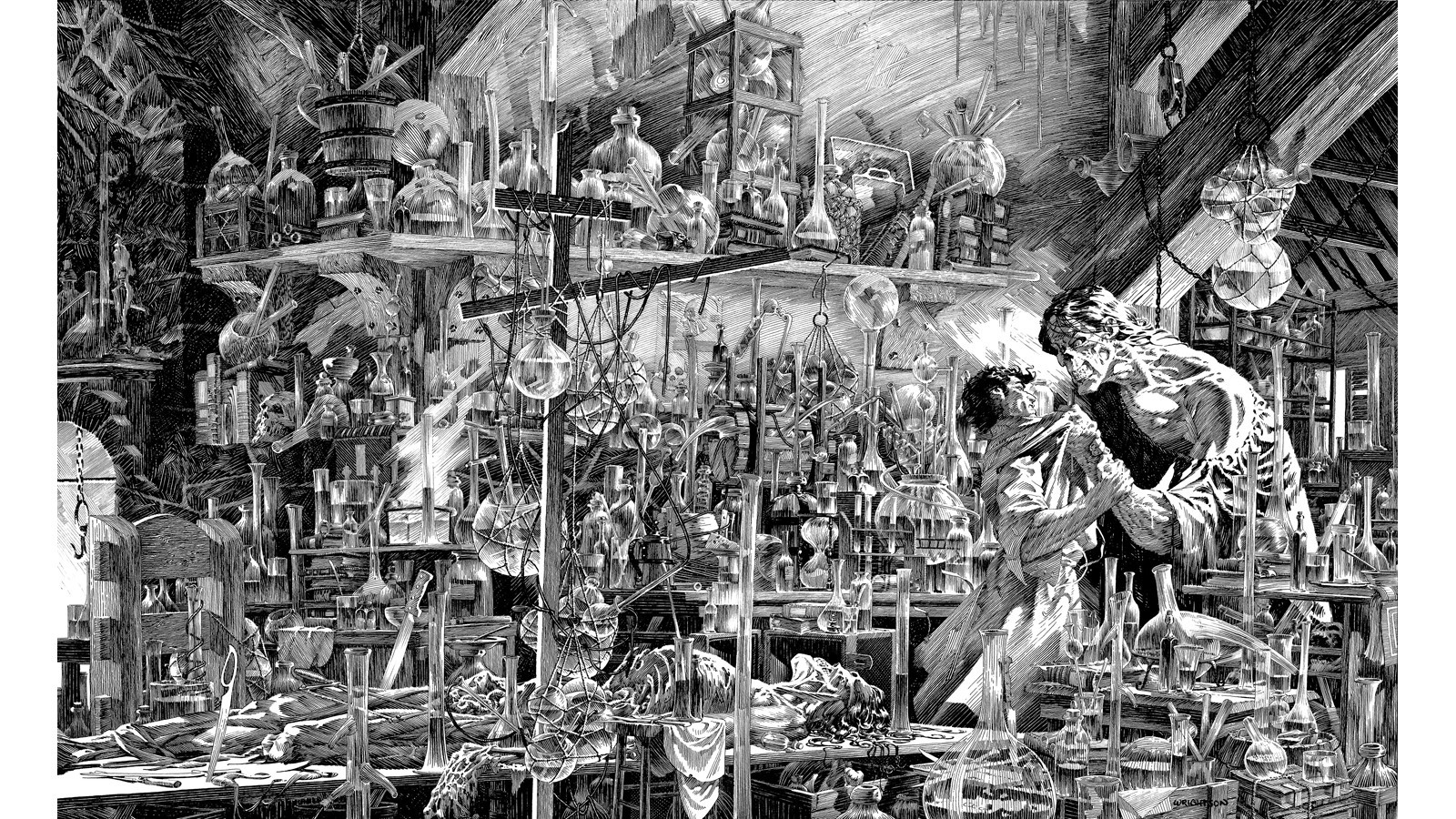 Is that gorgeous or what? Wrightson spent a long time on this and it shows. It's an obvious labor of love and you wish that any of the film monsters could catch this look. He gives it a hint of Karloff, around the eyes and forehead; but, pretty much follows Mary Wollstonecraft Shelley's descriptions. I was never a big horror fan; but, this is pure art! My only regret is that he never did an adaptation of Young Frankenstein. I'd love to have seen him handle Marty Feldman (who turned up in Star Child) and Madeline Kahn. |
|
|
|
Post by codystarbuck on Dec 16, 2018 0:48:32 GMT -5
10. Doc Savage: Man of Bronze #1 - 4 (Millennium, 1991) When this year's topic was announced, I found myself wondering if a Doc Savage tale would make my list. I am a huge fan of the Man of the Bronze, but he has never been particularly well-served by his comic book incarnations. Which is odd given that he was a huge influence on the development of both Superman and Batman. But, for some reason, his comic appearances have generally been lackking: from the underwhelming (Marvel's colour series) to the adequate (Marvels b&w magazine) to the misguided (DC's 1980s book) to the regrettable (DC's First Line book). And I found myself wondering why this is. The conclusion that I came to is that the comic books insist on putting Doc front and centre of the action. This is understandable. He is the central character after all, and the most visually interesting. But, in the novels, Doc tends be 'off-screen' for much of the action, with events seen through the eyes of Doc's aides, who are just as much in the dark as to Doc's plan as the reader. This strips Doc of much of his mystique. And the adaptations insist on shoe-horning all five of Doc's aides (and often Pat) into every story. Very few of the novels actually featured the entire cast, and this results in the comics feeling crowded, and not much room for character development among the Fabulous Five. So, after this 'insight', I found myself wondering if any of the adaptations did warrant a place on my list. To my surprise, I can up with two possibilities. After weighing things up, several intangibles, I decided on the Millennium series; partly because I feel it is the more obscure. In particular their first miniseries Doc Savage: Man of Bronze (which, despite sharing a title with the first Doc Savage novel, is not a retelling of it). This is a solid little tale. The writer understood the beats of a Doc Savage novel, and managed to hit them perfectly. And included some jokes for the fans, such as talking about getting the jetpack from a kid in California (a Rocketeer reference). And he did not feel the need to rewrite Doc to update him, or make him 'relevant'. What we ended up with is a solid Doc tale that would not be out of place in the novels (and would be better than some of them). The later minis are decent, but always felt a bit rushed, and the artwork deteriorated as the run went on, before finally sinking along with the rest of Millennium. But it is good to know that there is at least one example of Doc savage done right in comics. Excellent choice for Doc Savage. Millennium slipped under a lot of radars; but, they had some good books, including this one. They also did a Pat Savage Special that was a nice comic. Loved the Wild Wild West mini they did and the Man From Uncle mini. Not so keen on their iteration of the Justice Machine; but, that ship had sailed a while before and they at least tried. When I get done with Valiant I might have to dive into Millennium, in my Other Guys thread. Good excuse to go reread some of that. |
|
|
|
Post by codystarbuck on Dec 16, 2018 0:51:56 GMT -5
#10- GUMBY'S WINTER FUN SPECIAL & GUMBY'S SUMMER FUN SPECIAL Written by: Bob Burden & Steve Purcell Drawn by: Arthur Adams (1987-1988)  "He was once a little green slab of clay.... GUMBY!" Art Clokey's timeless animation was suitable to comics. I loved watching reruns of Gumby when I was little. When Comico made these in the mid-80s, this was a must pick up. I'm putting these together because you can't have one without the other. Bob Burden's comedy writing was a great start of the two specials. A right mix of all ages fun and little adult flair, like most of his comics are. Art Adams... would you ever expect him to draw Gumby and crush it like a champ? I'm a sucker for all things Art Adams and its so nice to see him do interiors, even back then! Winter Fun writer Steve Purcell, of Sam and Max fame, brought his own weird zany fun to Clokey's world. Gumby, Pokey, the Blockheads, underground monsters, astronaut bears.. these books are worth picking up  I remember when this came out; everyone was asking, :Why is Art Adams doing Gumby, instead of X-Men?" BECAUSE IT'S GUMBY, DAMMIT!! 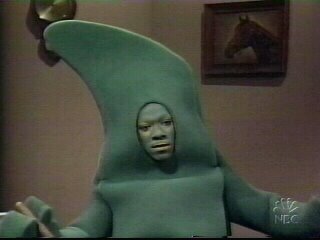 |
|
Crimebuster
CCF Podcast Guru
Making comics!
Posts: 3,958 
|
Post by Crimebuster on Dec 16, 2018 1:22:37 GMT -5
10. Fantastic four #10(Marvel, 1963)  It's true that Stan Lee and Jack Kirby only appear briefly in this comic. But This is far more than a cameo. First, the entire plot of the issue hinges on their appearance, as the pair are key to Doom's plot to capture Reed Richards. For that alone, I think this would qualify, and be a perfectly fun choice, as this is a rollicking yarn. More important, though, is the role this story played in turning Marvel Comics into "Marvel Comics," and Stan Lee into "Stan Lee." Plenty has been said about Stan's genius in making fans feel like they were part of something, that they knew the "Marvel Bullpen." Stan turned the previously faceless and nameless creators behind the comic into part of the experience, into cool celebrities. And it really starts here, as he literally adapts himself and Jack, turning the two of them into larger than life figures that can share a page with Reed Richards and Dr. Doom and not feel out of place. So in a strange way, this story is just the start of a much bigger adaptation. Because for the rest of his life, Stan Lee was in a real sense playing the character that he created here, adapting his own life after the comic book version fans believed was real, in order to make it real. Life, imitating art, imitating life. And it a super fun story! 
|
|
|
|
Post by Deleted on Dec 16, 2018 1:39:19 GMT -5
My number 10 is Bernie Wrightson's adaptation of Frankenstein.  Most people, when they adapt Frankenstein, look at the James Whale film, not the original novel. not Wrightson; he went to the source. He sets the story fully in the period where Shelley placed it, he makes it look like it was produced then.   Wrightson makes the illustrations look like woodcutts, of the period, which gives a creepy edge to everything. It is stark black and white, with tons of small details. It is just amazing to look at.  Is that gorgeous or what? Wrightson spent a long time on this and it shows. It's an obvious labor of love and you wish that any of the film monsters could catch this look. He gives it a hint of Karloff, around the eyes and forehead; but, pretty much follows Mary Wollstonecraft Shelley's descriptions. I was never a big horror fan; but, this is pure art! My only regret is that he never did an adaptation of Young Frankenstein. I'd love to have seen him handle Marty Feldman (who turned up in Star Child) and Madeline Kahn. While I love, love, love Wrightson's art on this, I passed on it for this topic because I didn't think it was really an adaptation or a comic really, it's Shelly's complete and unabridged novel printed with illustration pieces, not sequential art, but spot illustrations, from Wrightson, so I (not Kurt or anyone else) disqualified it from my list. Glad to see it get some love though. -M |
|
|
|
Post by Paste Pot Paul on Dec 16, 2018 2:31:00 GMT -5
The Adventures of Jerry Lewis DC Comics  Im not into funny books, Im not overly into Lewis as a comedian on film, but I do fondly remember these as a kid. Few and far between, but they always did the job. Ive always felt that the artist captured the innocence(and sheer stupidity) of Lewis's onscreen persona. Probably the only celebrity cash in book Ive ever liked too |
|